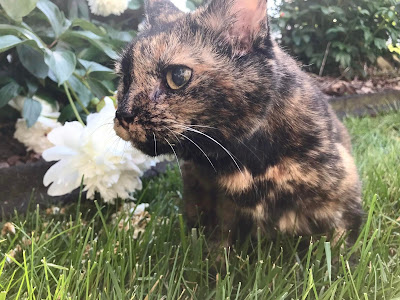 |
| Lucinda, Beating the Heat in the "WILD" Garden, July, 2016. |
Our cat Lucinda was struck and killed by a car. She died on the busy road in front of our house. A road she had steered clear of for the 11 years she lived with us in New Jersey. Lucinda was my constant companion when I gardened… except when I worked in the sidewalk “hell strip." I’d glimpse her through the fence posts supervising my work from the safety of the garden. What made her run into that busy street for the first time...now? We’ll never know.
Dave and I adopted Lucinda from the ASPCA in New York City in early 2011. Her behavior history read: Lucinda “can play rather rough…this cat is suitable for a home with no other pets or children.” Plus, she had health issues and was labeled obese. Despite her rap sheet, Dave and I were immediately smitten with Lucinda. Compared with all the other mewing, anxious cats at the shelter, Lucinda was chill. Anything new she took in stride: our NYC studio apartment, all-night parties packed with musicians, a new weekend home, the shuttling back and forth between NYC and NJ for years until we became full-time New Jersey residents five years ago.
Many people shared their views about cats and the outdoors: They don’t live as long if you let them outside. Too many strays in the neighborhood; she’ll get into fights. Cats are the "number one threat" to birds. Cats are not native to North America. If you love your cat and you care about birds, you’d keep her inside.
We listened to the advice. We kept Lucinda indoors during nesting season. As much as she wanted to stay out all night in the summer, we brought her in at bedtime. She got into a fight once and we had to quickly find a vet.
Dave and I also listened to Lucinda. The first time we let her go outside I put her in a harness and she shook from fear. I walked her like a dog because I was afraid she’d jump over a fence and not find her way back home. Grackles swooped down to let us know they did not like seeing a cat in their territory.
After I could see she was smart enough to avoid the busy road I let her roam. She darted across our new lawn into the safety of the viburnums.
When we began planting our native garden beds Lucinda watched every step of the way. My “Assistant Gardener” shows up many times in WILD in the Garden State, my documentary about transforming our lawn into a native plant habitat. She would follow me around everywhere and investigate where I was pointing my camera.
As soon as our first native garden was tall enough, she would ease into the cool interior on hot summer days. Lucinda immediately understood the value of native plants over lawn.
As a fat, city cat her hunting skills were pretty nil. The first tribute she brought me was a scavenged sparrow, covered in ants. She shook and chirped as she dropped it at my feet. New behavior.
Outside the confines of a studio apartment, Lucinda soon understood the fenced garden was hers. She daily made rounds, marking her territory and honing her outdoor skills. Soon, she brought tributes she must have killed herself. Dave put up fencing around the birdbath and feeders. We added several bells to her collar, and kept her inside during nesting season. All in all, she killed only a handful of birds. All were non-native, European House sparrows. I’m sure there were some strikes we did not see or prevent.
It’s not right to let cats kill birds. Nevertheless, we let our cat go into our native garden — a place that attracts birds. Her life was undoubtedly cut short because we let her go outside.
Like me, our garden is full of contradictions. We inherited a few non-invasive plants that I don’t have the energy or will to replace with natives. The Japanese Holly, Japanese Lily of the Valley and English Boxwoods do little more than sequester carbon.
Our suburban garden is a safer place for the birds now that Lucinda is gone. I’m comforted to see so many birds finding food and shelter here as fall turns to winter. I also feel incredibly grateful to have a garden where a fat, unwanted cat found love and a home.









.jpeg)































